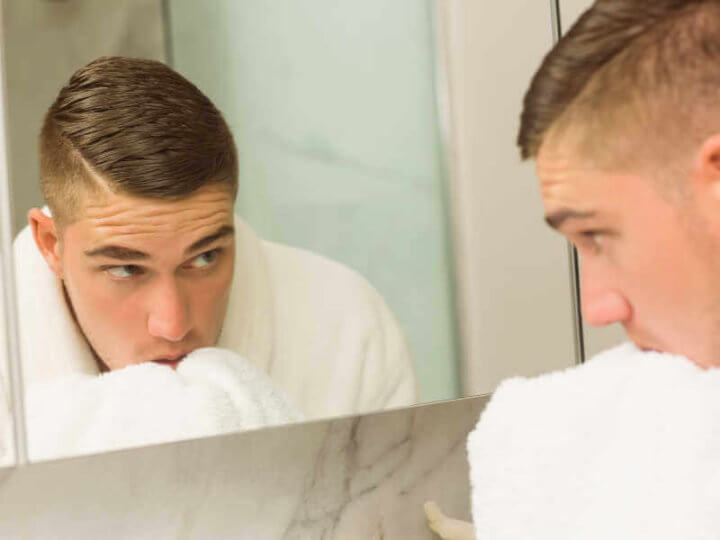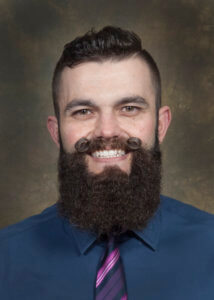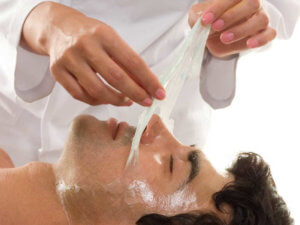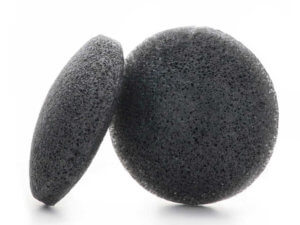
[Updated April, 2021] Rub a dub dub, it’s time for a facial scrub. Or maybe not. Should you exfoliate before or after shaving? Experts offer their advice.
The Standard Advice

Standard shaving advice is to clean your face before you shave. Dr. Steven Daveluy, M.D., FAAD and associate professor and program director at Wayne State University dermatology, says washing before shaving helps hair absorb the water, making them easier to cut. Oil and skin cells can accumulate and washing them away with a gentle cleanser or mild exfoliating scrub can help remove them to allow the hairs to stand up better for shaving. This will make shaving go more smoothly, reducing nicks and irritation, he points out.
However, other sources recommend a more vigorous pre-shave exfoliation and that’s where it gets confusing. The bad news is that there is no single approach to exfoliation that will work for everyone’s face. The good news is that there are useful guidelines to help find an exfoliation strategy that will work for you.
Scraping the Surface
The motivation for exfoliation is based on how the skin works and Dr. Daveluy says there are benefits and possible drawbacks with exfoliation. Exfoliation removes some of the dead skin cells that form the skin surface, as well as oil and debris that can accumulate, he explained via email.
Normally the skin cells go through a progression from the bottom layer to the top. They form a layer of dead skin cells that helps protect our skin from the irritants, allergens and germs of the outside world. When functioning normally, the dead skin is shed at the right time and our skin looks normal and healthy. When the skin isn’t functioning normally, these dead skin cells can build up and make the skin appear flaky or dull.
Exfoliating means removing some of the dead skin cells, oil and debris by using a chemical or physically removing them, he explains. If your skin appears dull due to a buildup of cells, then exfoliating can make it appear brighter and less dull. When exfoliating removes these skin cells, however, it can also increase the risk of irritation and even infection since this skin layer does serve an important function. Exfoliating is about balance and it’s based on each individual’s skin, he cautions.
Timing And Frequency
So, exfoliation can help your facial skin, but how you should you plan it around your shaves?

Stan Ades, founder of Pacific Shaving Company, agrees with Dr. Daveluy’s assertions and maintains that it’s also beneficial to exfoliate at night before bed. By adding a second, gentle exfoliation before bed, you are removing dead skin cells’ free radicals that have accumulated throughout the day and then giving your skin time to rest and rejuvenate before you take a razor to it the following morning, he says.
Zsolt Bagdi, director of product development with Harry’s Inc., agrees that men should exfoliate before they shave. A face wash with gentle exfoliation like Harry’s Face Wash is a perfect daily pre-shave treatment, he believes. However, if you want to use a more effective once-a-week facial scrub, he recommends using that the night before a shave, which allows some time for the skin to recover.

Other sources recommend less frequent exfoliation. Dr. Seemal Desai (@SeemalRDesaiMD), founder and medical director of Innovative Dermatology in Dallas, Texas, argues against exfoliating every day. He believes that three times a week for a few minutes is sufficient and that skin type influences timing.
“If you’re someone who has sensitive skin, it’s probably not a good idea to do an exfoliating cleanser or product right before your shave because that’s going to further irritate the shaving process,” he says. “However, if you’re someone like me who is oily, I combine my exfoliation and cleansing right before I shave because I actually want to remove some of that superficial debris to help with the skin.”
Dr. Desai also warns against trying a new exfoliating product immediately before shaving. Even if you think you do not have sensitive skin, he says, it’s best to test the exfoliant separately to learn how your skin reacts to it.
Sources did agree that you should not exfoliate too soon after shaving. A representative for Walker & Company Brands, makers of the Bevel line of shaving products, notes that immediately after shaving, the skin is more sensitive so another form of physical or chemical exfoliation isn’t needed. For many, gently exfoliating again on the next nonshave day is acceptable. This can actually help prevent ingrown hairs and those with more sensitive skin will want to give their skin additional rest.
Chemical Or Physical?

[Ed. Note: Amazon links are Sharpologist affiliate.]
There is a range of exfoliation methods available. Mechanical exfoliations use face cloths, brushes or sponges, typically combined with a facial wash liquid, to scrub the skin. The granularity of the liquid will determine whether it’s mild or harsh. Chemical exfoliations generally use ingredients like alpha and beta hydroxy acids that dissolve dead skin cells. Dr. Daveluy says that the only method of exfoliation that has been studied in shaving was a comparison using bar soap to wash before shaving with using cleanser to wash beforehand. In both cases, shaving was followed by applying a glycerin-based moisturizer.
“The group that washed with the cleanser had better moisturization following shaving,” he says. “So, the only exfoliation I recommend is using a cleanser to gently scrub the face before shaving. I would avoid anything beyond that since can increase the risk of irritation.”
Dr. Desai echoes those concerns. “I think the dogma is that exfoliation is good for your skin—that exfoliating and peeling off those dead skin layers is good for you,” he notes. “The answer is minimal to mild exfoliation is good. Heavy exfoliation at home is something I do not recommend and I advise against. Excessive, aggressive exfoliation can lead to harming of the skin, excessive dryness and fissuring of the skin. It can also lead to dermatitis and inflammation if you do too much. At-home chemical peels, at-home deep exfoliants or vigorous scrubbing—I’m not an advocate.”
A Walker & Company Brands representative says that depending on skin needs, doing both physical and chemical exfoliation can be beneficial to reduce dark spots and provide a more even skin tone. Those with oily skin, acne or sensitive skin might prefer chemical exfoliation as it is typically less abrasive. “If someone is just starting to exfoliate, we recommend starting with just one to two applications a week and building up to establish a personalized regimen from there,” the source writes in an email.
Bagdi observes that because “men have thicker skin than women, both methods and combined methods are great to slough off dead skin cells, soften, and uncover healthier looking skin.” However, he does warn that “if a more abrasive physical or chemical exfoliation is used, one must allow the skin to recover between treatments.”
There are alternatives to soaps and chemicals; Ades recommends Pacific Shaving Co.’s natural Konjac sponge, which does not require a facial soap to work.

“It is impossibly gentle and can be used anywhere on your body including eyelids,” he says. “It gently and naturally cleans and sloughs off dead skin without the need for any cleanser or drying soap. Because of its softness, you can use it as often as you want without worrying about damaging your skin.”
Ades cautions against chemical exfoliation, which can involve applying the exfoliant to your face and leaving it on or removing it after a while as instructed.
“I would not suggest chemical exfoliation,” he says. “Exfoliation already has the potential to be rough on your skin. I would not add chemicals into the mix.”
Traditional Wet Shaving And Exfoliation
An argument against exfoliation is that traditional wet shaving methods, specifically the use of a brush for applying cream and multiple passes with the razor, already provide adequate removal of dead skin cells.
“With the brushes you want to be a little careful,” says Dr. Desai. “Some of the brushes are pretty thick-bristled and exfoliate themselves. With those, I do not recommend an additional exfoliant. If you’re someone who likes to do multiple passes—I typically don’t advocate for that—then I definitely do not suggest exfoliating before that. The process of shaving, going north to south, is exfoliation itself and you don’t need a double-layer exfoliation.”
Shavers can develop problems if the exfoliation method is too strong, Ades warns:
“With each pass, the razor is crossing the skin, so the more passes, the more likely you’ll get irritation. So be careful with particularly coarse, rough or chemical exfoliating methods—it will only make your skin more irritated and drier. And, as your sin becomes too dry, your body works to create more oils to offset the dryness, which can then lead to breakouts.”
Bagdi and Dr. Daveluy don’t believe that traditional shaving methods necessarily change the need for exfoliation.
 “We like to recommend the use of the brush because it provides a gentle exfoliation and perfect prep for the shave,” says Bagdi. “If gentle physical or chemical exfoliation is part of one’s face care routine (face wash, AHA/BHA containing face care products, masks) it will be cumulative, but moderate enough that it is not harmful in the area where men shave. As mentioned previously, if a more abrasive physical or chemical exfoliation is used (full face), one must allow the skin to recover between treatments.”
“We like to recommend the use of the brush because it provides a gentle exfoliation and perfect prep for the shave,” says Bagdi. “If gentle physical or chemical exfoliation is part of one’s face care routine (face wash, AHA/BHA containing face care products, masks) it will be cumulative, but moderate enough that it is not harmful in the area where men shave. As mentioned previously, if a more abrasive physical or chemical exfoliation is used (full face), one must allow the skin to recover between treatments.”
My Own Experiences
I can attest to the need to rest your face. As part of the research for this article I used a mild exfoliating face wash a few hours after shaving but stopped immediately because my skin was too tender. No surprise there, but when I tried again the next day when 13 hours had elapsed from my morning shave and even then, it was still uncomfortable.
I’ve tried different exfoliation products for pre-shave and general use. Here are my impressions of three products I’ve tried in the past few years, listed by decreasing aggressiveness (grittiness). Prices are from Amazon or the manufacturer’s site. I found that any preshave exfoliation resulted in my shaves being too close, at least for my preferred razor and blade combinations, leaving my face too tender post-shave, so now I try them only on my non-shave days.
Art of Shaving Facial Scrub Peppermint Essential Oil; Scrub, 3.0 oz, $25
- Instructions: Recommend using it twice a week or as needed. It’s not meant to be used immediately before or after shaving.
- Impression: Too gritty for my skin and I stopped using it after a few times.
Lab Series Skincare for Men Multi-Action Face Wash; Face wash, 3.4 oz, $26
- Instructions: Morning and night, massage a small amount over wet face and neck. Rinse well.
- Impression: Milder than the AoS scrub.
Harry’s Face Wash with Peppermint; Face wash, 5.1 oz, $7
- Instructions: Apply to wet face. Gently massage. Rinse. Use daily.
- Impression: Very mild; good value for price. I use it on my nonshave days.
Useful Guidelines For Exfoliation From The Experts
Every shaver’s face is different so it’s not surprising that there is no one-size-fits-all approach to exfoliation. But it is possible to highlight some useful guidelines for working it into your routine:
- If you’re shaving with a brush and doing multiple passes, you might not need to exfoliate separately.
- Mild pre-shave exfoliation can improve your shave and skin unless your skin is very sensitive, in which case you might want to restrict it to your non-shaving days. If your face feels too tight after a post-exfoliation shave, rethink your method.
- Give your face adequate rest time after shaving before exfoliating.
- Be careful with harsher methods, both chemical and mechanical. If you’re going to try them, ensure adequate time after and before shaving.
- If you exfoliate apart from pre-shave prep, apply a moisturizer to the exfoliated skin.
About The Author:
Ed McCarthy is a semi-retired freelance writer living in rural northwestern Rhode Island with his wife and too many razors. Despite numerous shaving experiments over the past 50 years he has somehow managed to avoid completely destroying his face.

I cleanse with the Satin Smooth Hydrasonic Dermal Cleansing Kit, Rechargeable Cleansing Facial and Body Brush before shaving. I use the Sensitive Skin Facial Brush attachment and COSRX Low pH Good Morning Gel Cleanser because it’s gentle on sensitive skin. I think I paid around $70 for the Hydrasonic Kit years ago. It’s still working and was worth every penny. I can’t believe how cheap it is on Amazon now! link
Caveat Emptor: Beware of beauty supplies such as shampoos and cleansers sold on Amazon and department store. Many if not most are counterfeit. The beauty supply industry is highly unregulated. Buy from a salon or authorized seller. https://www.cosrx.com/north-america-stores
A few months ago, I upgraded from the COSRX Low pH Good Morning Gel Cleanser and Satin Smooth Hydrasonic Dermal Cleansing Kit [worn out non-replaceable battery] to EltaMD Foaming Facial Cleaner and a Foreo LUNA 3 for Sensitive Skin.
I have sensitive skin and some rosacea so Forea recommended their Sensitive Skin model. It’s much gentler than a spinning nylon brush but cleans just as well. Actually, I think it cleans better. The upfront cost is higher but there’s no disposable head to replace and the massage function is cool. I don’t know if it actually tones the skin but it helps massage in my aftershave and night moisturizer. I’ve owned it for 3 months and haven’t had to recharge the battery yet! Very high build quality. Foreo said it will last a few years and when it eventually wears out, they offer a discount on a new one. Highly recommended.
As for the EltaMD Foaming Facial Cleaner, it kind of moisturizes while it cleans. It’s a very gentle, non-irritating facial cleanser. It’s expensive but a little goes a long way.
I rub my wet whiskers with a bar of glycerin pre-shave soap “ala” a shave stick then work up a pre-lather with my palms as a pre-shave lubrication and exfoliation.
I then work my shave soap/cream/croap in its tub or in a scuttle and apply it over the glycerin soap pre-lather.
Very diverse and informative article. My only surprise was that it took so much reading before getting to the actual truth about exfoliation and shaving….
The very act of scraping a sharpened piece of steel across your skin will, in itself, provide all the exfoliation one needs, particularly when you contemplate the fact that, by doing just that, you’re removing up to two layers of skin with each shave.
The ‘damage’ to your skin is greatly increased with the use of multi-blade razors as using them results in 3, 4, 5 or now even 6 pieces of sharpened steel being scraped across your skin!
In my 40 years as a traditional Barber, having shaved more types of skin than I care to remember, it is clearly apparent to me that, if you shave correctly (max 2 pass: with and across grain) using quality shaving products that will prepare your beard and skin accordingly, and importantly, utilise the minimum amount of steel IE 1 blade of good quality, followed by a quality skin food (balm) that will aid the healing process at the end of the shave, the vast majority of men need never exfoliate their face using any other method.
Excellent article. Loaded with good info.
Exfoliation is done by shaving.
There should be little need to exfoliate where you shave.
Other parts of the face sure.
A well chosen cleansing soap can remove oils that keep water from softening whiskers. It is not silly to use a puck of Williams as a bar of soap for this purpose. Because water chemistry is different the soap or detergent(soap) product you like will be up to you and is often a local decision. A soap for cleaning needs no fragrance or hyper fat additions beyond the trivial extra amounts necessary to react 100% of the caustic in the saponification process.
I recommend trying a new hard shave soap as if it was a bar of soap.
Grab it, wash your hands, should be nicely slippery; rinse should rinse clean in your water. Next wash your face as if shaving was not a goal. Next, take advantage of your stubble and scrub some soap on your now clean and wet face and face lather with a nice brush.
Or not.. do what works for you, you skin, your whiskers, blade choice etc.
Skin problems … consult your doctor or dermatologist.
Thank you,
Grey
Thank you. Merry Christmas.
Comments are closed.